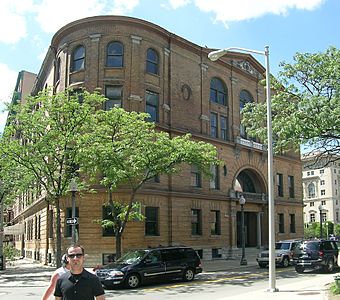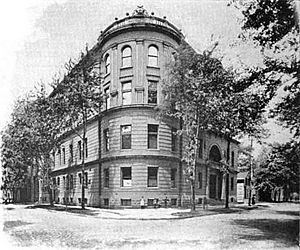Harmonie Club (Detroit, Michigan) facts for kids
|
The Harmonie Club
|
|

The Harmonie Club from the south
|
|
| Location | 267 East Grand River Avenue Detroit, Michigan |
|---|---|
| Built | 1894 |
| Architect | Richard E. Raseman |
| Architectural style | Beaux-Arts |
| NRHP reference No. | 80001924 |
Quick facts for kids Significant dates |
|
| Added to NRHP | September 4, 1980 |
The Harmonie Club is a historic building in Detroit, Michigan. It stands at 267 East Grand River Avenue in the city's downtown area. This special building was named a Michigan State Historic Site in 1975. Later, in 1980, it was added to the National Register of Historic Places. This means it's a very important place in history.
Contents
History of the Harmonie Club
Detroit's streets were designed in a unique way by Augustus Woodward. This plan created interesting triangular blocks. One of these areas became Harmonie Park in the eastern part of the city.
In the 1830s and 1840s, many German immigrants came to Detroit. They wanted to keep their traditions alive. So, in 1849, a group of Germans started a singing club. They called it the Gesang-Verein Harmonie.
The club built its first clubhouse in 1874. It was a wooden building. Sadly, this building burned down in 1893. The club quickly held a contest for German architects. They wanted a new building designed. Richard Raseman, who also designed the Grand Army of the Republic Building, won the contest. The beautiful new Harmonie Club building was then built across from Harmonie Park.
Architecture and Design
The Harmonie Club is a four-story building. It has a sloped roof and a basement. The building is made from light-colored brick and stone. Its curved corner is special because it fits the unique shape of the land.
The first two floors have fancy stonework. The top two floors have decorative bands and arched windows. There are also Corinthian columns and a balcony over the entrance. These details give the building a classic, elegant look.
Inside, the club has beautiful plasterwork. There is also dark oak wood paneling. You can also see special Pewabic tiles. In the past, the club offered many things for its members. These included fine dining, a tavern, card rooms, a bowling alley, and comfortable lounges.
What the Harmonie Club is Used For Now
Over the years, fewer people joined the Harmonie Club. The building was sold in 1974. It stayed empty for many years, until the 1990s.
By 2007, the city of Detroit had plans for the area. They wanted to create a cultural district around Harmonie Park. The Harmonie Club was part of this plan. The state of Michigan recognized it as a historic property in 1975. It was added to the National Register of Historic Places in 1980. The city of Detroit also recognized its importance in 1988.
In 2024, the Harmonie Club was used as a place for the Detroit Bridgerton Themed Ball. After this event, the owners of the Harmonie Club made a statement. They said that the historic Harmonie Club is a new place for events. They also explained that they are not connected to the people or groups who rent their building. They said that the groups who rent the venue are in charge of planning and running their own events.
See also
 In Spanish: Harmonie Club (Detroit) para niños
In Spanish: Harmonie Club (Detroit) para niños
- Harmonie Centre
- Music of Detroit


